originally posted at https://canmom.tumblr.com/post/690392...
So. Hello everyone! Welcome back to Animation Night.
In the misty olden days of Animation Night, back on #11, we held a night on French animation. On that day we were going to watch The Rabbi’s Cat, directed Joann Sfar. But, unfortunately, the torrent gods were not kind enough to grant me seeds, and so we didn’t get the chance.
But in the time since, it seems a seed managed to log on! So we can finally see what we missed…

Joann Sfar, then! Sfar is a French comics writer and artist, of the major figures of a ‘new wave’ of bandes desinées in the mid-2000s. He’s got quite a set of parents: his mother Lilou was an Ashkenazi-Jewish pop singer from Ukraine, and his father André Sfar a Sefardi-Jewish lawyer from Algeria who spent his career taking down neonazis.
And if that’s not enough, Lilou died when Joann was just three years old, so he was raised by André along with Lilou’s own father, a Ukrainian military doctor who during WWII was able to save the injured right hand of the novelist André Malraux, author of La Condition humaine (known in English as Man’s Fate) and thereby secure himself French citizenship. This information I’m just copying from Wikipedia, but it seems to be sourced from interviews with Sfar.
All this is relevant, because Sfar channels a lot of his life into his works. The Rabbi’s Cat in particular draws on his father’s life in Algeria, in the 1920s when Algeria was a French colony (forty years before Algeria would secure its independence).

A brief word on the background to this: by 1830, Algeria had been controlled for hundreds of years by the Ottoman empire, during which period it enjoyed more or less independence, sometimes even having wars with other Ottoman subjects. It was one of several homes of the ‘Barbary pirates’, who attacked European towns and ships primarily to take slaves.
It seems that these ‘pirates’ were continuous with the state, with the ruler’s title of Dey established by the corsair captains in 1671, and recognised by the Ottomans as regent from 1710, taxing a countryside ruled by ‘autonomous tribal states’ (a phrase due to Helen Chapan Metz, whose Algeria: A Country Study seems to have been paraphrased to make the Wikipedia article.)
Despite many Deys getting assassinated, this arrangement remained stable and lasted up into the 19th century. Gradually, though, the European powers started to win the naval wars: the Spanish leveled the city of Algiers in 1784, the US defeated the Ottoman Algerians twice in the early 1800s, and then an Anglo-Dutch fleet showed up in 1816 to bombard Algiers again. Finally, the French invaded in the 1830s, taking first Algiers and then gradually the rest of the country by 1875 and killing ‘approximately 825,000’ indigenous Algerians in the process through ‘scorched earth’ warfare and resulting disease, reducing the population by around a third.
After the end of the war, thousands of French and European settlers moved into Algeria, and the French ran a program of forced assimilation, while confiscating communal land from the ‘tribal peoples’ for the private benefit of European settlers, while suppressing the native Muslim population. Eventually, following the end of WWII, Algeria would throw off French rule after a brutal war in which they faced concentration camps, rape, torture and arbitrary, gruesome executions, a period famously written about by Frantz Fanon’s The Wretched of the Earth; all of this proved a terrible way to control a population and the Algerians fought back hard, until the French begrudgingly accepted Algerian independence in 1962. Since then, the country has mostly been ruled by the FLN, the primary nationalist party.

This story takes place roughly in the middle of French rule, during the 1920s. The premise is that a cat belonging to a Sefardi rabbi eats a parrot, gaining the ability to speak; deploring the cat’s behaviour and sarcasm, the rabbi decides he ought to teach the cat Torah, which throws open a theological can of worms.
So, more historical background! Jews in Algeria during the period of French colonisation were allowed to gain French citizenship while Muslims were not, putting them in the awkward (and perhaps all too familiar) position of go-between for colonisers and colonised and potential scapegoat. During the war for independence, the FLN appealed to Jews to side with them, but a large part of the Jewish population sided with the French instead; after the war, only three-generation Muslims were given Algerian citizenship and almost all the Jewish population of Algeria fled to France, André Sfar presumably among them. So that’s the background inflecting Joann’s life; by the time he was born in 1971, the war was over, and all of this he could only hear second hand.
The Rabbi’s Cat began life as a comic book series which ran from 2002-2006, went on hiatus, and then resumed in 2015 with near-annual releases up until 2021. I haven’t read it, but you can read a brief review of it here.
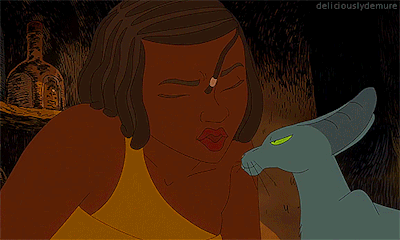
So now we come to the actual animated film, created by Sfar’s own Autochenille Production, a company founded in 2007 to make “author-driven, challenging films to appeal to children and adults” named after a car that features in The Rabbi’s Cat. It is funded by multiple French TV networks; I would not be surprised if it also had a bunch of government arts council funding like the vast majority of European animated films. It dropped at - where else? - Annecy in 2011, and duly won the award.
Of its production, most information is only available in French, but luckily the MTL is pretty good. Sfar had been bombarded with offers to adapt his comic, refusing all of them; he only thought of directing it himself when his editors asked him why. He was accompanied by two more experienced directors of animated films, Clément Oubrerie and Antoine Delesvaux, and brought in a lot of younger animators such as the ‘band of little geniuses’ Hugo Ferrandez, Grégory Elbaz, Gabriel Schemoul and Agnès Maupré with fine arts backgrounds, plus a couple of experienced animators in Jean-Christophe Dessaint and ‘Zyk’ who I believe helped with shooting video reference.
The animation process involved shooting a lot of live action reference footage with pre-voicing; their inspiration went back to early Disney (Animation Night 84) and Fleischer (briefly discussed Animation Night 21). Of Fleischer, Sfar says (google translation):
“Leurs dessins animés ne s'adressaient pas qu'aux enfants, raconte Sfar. On y voyait des histoires d'amour, des voyous, des vraies bizarreries. Le studio Fleischer était très cosmopolite, un mélange d'immigrés juifs et italiens. Toutes leurs musiques étaient faites par la crème des jazzmen noirs. Plus quelques vrais truands parmi les bailleurs de fonds.”
“Their cartoons weren’t just for children, says Sfar. We saw love stories, thugs, real oddities. The Fleischer studio was very cosmopolitan, a mixture of Jewish and Italian immigrants. All their music was made by the cream of black jazzmen. Plus a few real mobsters among the backers.”
Visually, he had ambitions: in contrast to Persepolis, clearly a big inspiration, he wanted to do something ‘truly cinematic’ with ‘great spaces, depth of field’ inspired by Fritz Lang, Fellini and del Toro. Sfar had directed one film before this in live action, but this was his first time in animation. Not that you’d know it: a quick scan through shows the film is full of nice little subtle bits of character acting, and the backgrounds have an unusual style that takes after the comics in using flat shading, thin black lines and hatching.

It doesn’t always quite work (scenes of perfectly static water ripples are especially odd), but it’s certainly distinctive.
Narratively, the film goes through a series of episodes, eventually turning on the Rabbi, his cat and a Soviet painter going out on an expedition into the desert intending to find a country of Jews in Ethiopia. Reviews particularly speak of the film’s illustration of kinship between Jewish and Arab people; they are sometimes critical of the plot’s meandering but generally come out to praise the film. And it comes with a friend’s recommendation as well, so I’m looking forward to it a lot.
It seems to be Sfar’s only animated film, sadly. He was a producer on Aya of Yop City, another autobiographical comic-based film directed by Ivorian author Maruerite Aboute and Clément Oubrerie; a big step up for French animation set in Africa insofar as its director is actually African (*looks sternly at Kirikou*). Unfortunately, I have not been able to track down a copy of this film.
Then, to round out our program, we have a little oddity from 2014: a package film that brings together renowned independent animators from across the world. That film is The Prophet, adapted from the 1923 book of mystic parables by the Lebanese-American poet and writer, Kahlil Gibran. The film is the passion project of actress Salma Hayek, directed by The Lion King director Roger Allers; it comprises a unifying CG story about the meeting of a young girl and a too-good-for-this-world poet, framing a series of short musical sequences based on Gibran’s poems, each one directed by a well-known independent animator in their characteristic style.
Of the list, then, one is Sfar (hence the inclusion in this night). Others include the brilliant Tomm Moore of Cartoon Saloon (Animation Night 14, Animation Night 49) and Bill Plympton who we met a few weeks ago (Animation Night 112), as well as Mohammed Saeed Harib from the UAE, creator of the FREEJ series, and Paul and Gaetan Brizzi, a pair of twins who have both worked together on French animation such as Asterix vs Caesar and Babar before joining Disney in 1990 and working there for several decades during the ‘renaissance’ period. With such a diverse and talented set of animators on board, how could it possibly go wrong?
Unfortunately, the last inclusion is… more of a problem for me. Nina Paley is an independent animator and copyleft proponent known for her two religious satire films Sita Sings the Blues and Seder-Masochism… and also an active TERF, like, and I don’t mean this in the sense of ‘said some nasty things once or twice’ but like, ‘outspoken proponent of the “gender critical” hate-cult movement’. She’s one of those people in the open source movement who just seem to think that, after making a few breaks from the social dogma, they have everything figured out, and then immediately take a massive shit on some other group of people. And it inflects her movies too; Seder-Masochism is a gender-essentialist fable all about how patriarchal authority covered up the good wholesome womens’ version of Judaism, which is hard to swallow with the TERF thing running under the surface. So as far as I’m concerned, she can fully fuck right off; I will show some films by some pretty dubious people but this one’s personal lmao; don’t expect to ever see Animation Night: Nina Paley.
On top of that, we can add the casting of Liam Neeson as the voice of the poet. To be fair, when this film came out, Neeson’s bizarre racist diatribe had yet to happen, but his voice just sounds glaringly awful in the role of ‘the poet’, the intonation of an American reading out quotes in a civ game. It sounds bad enough that I went looking for a copy of the French dub, without success. The trailer ends with him going ‘my crime? poetry.’ in a voice like we’re supposed to go oooooh, how could they and not just burst out laughing. I went looking for the French dub as more likely to be bearable, but I can only find it in English.
So the production seems like kind of a mess. What I might do is just like, fast forward the framing story and show only the guest segments, since they’re really the only reason I’m interested in this thing in the first place. Still, it is the only other piece of Sfar animation I have to hand, and I do think there is likely to be some gorgeous animation in those guest segments.
And that’s about all I have time to write. Animation Night 114 will begin at around 8pm UK time, around 4 hours from this post, at picarto.tv/canmom - until then I will be working on my Chroma Corps character, so please feel free to drop by!
To follow up on this briefly a week later!
The Rabbi’s Cat was delightful in the end. It definitely wears its message on its sleeve - Rabbi Sfar and Sheik Mohammed Sfar have a lot in common, fanatics suck (as in the scene where the Tsarist fanatic and the young man from the Muslim group in the desert kill each other), don’t do an racism - but they aren’t bad messages and there’s easily enough wit in the writing that it doesn’t come off as overbearing. It definitely feels like a compilation of episodes, with the second half of the movie only loosely related to the first, but that doesn’t really hurt it. And the animation proved excellent, as expected.
I wrote quite a bit about the film up above, so I probably don’t need to say too much more than that. Though I will say, the parody of Tintin in the congo is very funny. A version of Tintin appears…
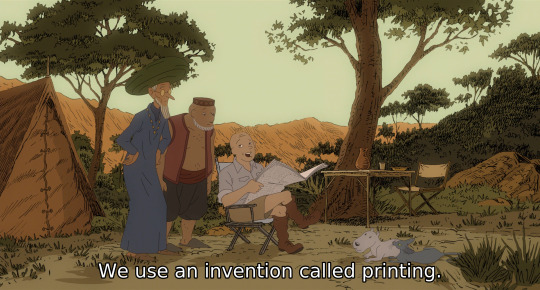
…as an arrogant condescending tourist with (I’m told) a thick Belgian accent.

The point where they actually find the Ethiopian Jews (the Beta Israel) is… curious. The Russian pogrom-refugee character, who motivated the whole expedition out of a romantic desire to find this Jewish homeland, finally finds what he’s looking for, and they’re giant supermen who greet the main characters with hostility. The characters get a lot more stylised at this point, for both the MCs and the Ethiopians…
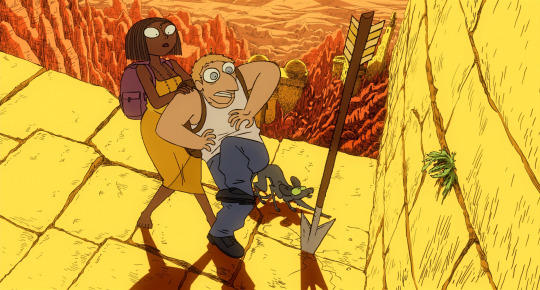
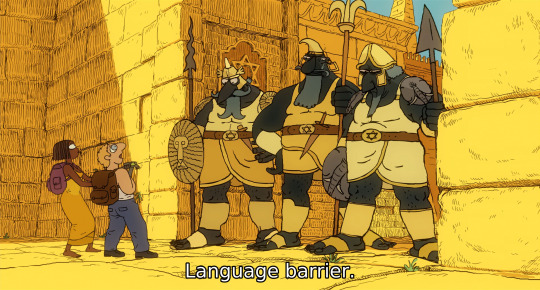
So it’s clearly playing off… less the actual Beta Israel who are obviously just some guys like anyone obviously, and more the romantic idea that the Russian character holds; I don’t really know the history of this mythology to be able to fully parse what it’s doing here.
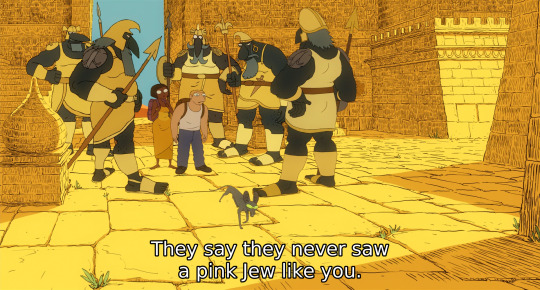
In any case, while the Russian tries to negotiate, the Cat, who has been a minor character for most of the expedition, goes and has a look around. So here are the images we see…

…an old guy playing what I think is a masenqo with a weird staring expression,

girls washing big pink elephants,

who immediately give the Cat a bath and try to play with him, much to his displeasure,

and then he sees a Bar Mitzvah taking place, and jumps in trying to finally have his own Bar Mitzvah; this causes him to get chased out of town. Meanwhile the Russian has earned ire by making a drawing of the soldiers at the gate. The cat is unable to calm them down, but declares they’re just like the rest of humanity and he prefers cats, then departs.

so… it’s hard to see much hostility in the depiction of the Beta Israel, who mostly seem to end up put in a ‘straight man’ role to the MCs’ antics, but for a film that has mostly gone out of its way to portray what people have in common, it was a little surprising to have them presented as so ‘other’. I guess the point of the art style change to something more caricatured is to present this as more of a fantasy, and indeed, the Sfars aren’t told that the city was real.
Anyway, the film ends shortly after this; the Cat, the Russian painter and the African girl return to the two Sfars and set off home, and we end with a match cut of the sky to the Rabbi’s daughter Zlabya (and the Cat’s one-sided love interest lol).
And then, as for The Prophet…
Unfortunately, it did not manage to exceed my low expectations when viewed as a whole. Certainly, there were many beautiful guest segments with a lot of styles of gorgeous animation, and I think a wonderful film could be created if you took the animation from these guest segments only… and probably completely revoiced and re-scored them. I still feel that Neeson is a terrible pick for the prophet character. But…
…what most undermines it is the framing story. The book The Prophet keeps things simple: Mustafa decides it’s time to go home for his own reasons, and meets a series of people on the way, dispensing wisdom. The film instead tries to cast him as persecuted folk hero, combining Kahlil Gibran (who wrote critically of the Ottoman Empire on occasion) with actual political prisoners in a setting that is roughly based on Lebanon at the time the book was published. Instead of simply leaving on a boat, Mustafa is executed by the Ottoman authorities for fomenting insurrection - but oh, he appears on the boat anyway, because his spirit will live on in his poems etc. etc.
I am not against such a story on the face of it, although it seems an odd thing to do for a man who was not executed by the Ottomans but died in America as an already world-renowned author. Indeed, such a story of a poet killed by an imperialist state can be expressed to devastating effect, as in Mili’s song Salt, Pepper, Birds and the Thought Police, about the Korean poet Yun Dong-Ju who was killed in prison by the Japanese authorities in 1945.
Unfortunately, The Prophet is unable to stick such a landing at all. Or even the takeoff, let alone the aerial moves. The story is clearly leaning on a Disney formula, centering on a young mute girl who eventually regains her voice, but the CG animation is so janky and lacking in the charm of traditional animation that it falls completely flat. (One scene has the CG characters walk past some traditionally animated sheep, and it is kind of painful how much better the sheep look than the main characters of the film). For a story about something as serious as a political prisoner being executed, the characters are far too zero-dimensional; you have archetypes like the nice handsome Ottoman prison guard who is going to get with the MC’s mum, and the evil ugly Ottoman commander who orders Mustafa’s execution despite the fact that everyone loves him, with nothing done to complicate their archetypes at all.
And for a film that is ostensibly there to celebrate Gibran’s poems, it just feels utterly extraneous and drags down all the other animated segments. Surely the poems should be able to stand alone, without the film falling over to tell us how beloved by everyone (except evil people) Mustafa is.
For this reason, I really wish there could be a recut of the film that just dispenses with all the crap, replaces Neeson’s voice and the weak musical settings of the poems, and gives the guest animation segments a proper showing. The hard part would of course be redoing the sound - you could cut out everything but the animations in ten minutes or so using any old video editor. Still, replacing the frame story with something truer to the book, done with a less cloying animation style, would be a welcome replacement as well. A series of short films based on poems by different animators can be absolutely charming - just look at Winter Days (Animation Night 100, not that I said much about it then! I’ll have to flesh that out some time)
It’s not bad for adaptations to change their source material to better suit a new medium, but this is a sad case study in how not to do it. And honestly, enough with celebrity voicing. Voice actors should be recognised in their own right, not just considered a price for making a film poster more attractive.
Comments